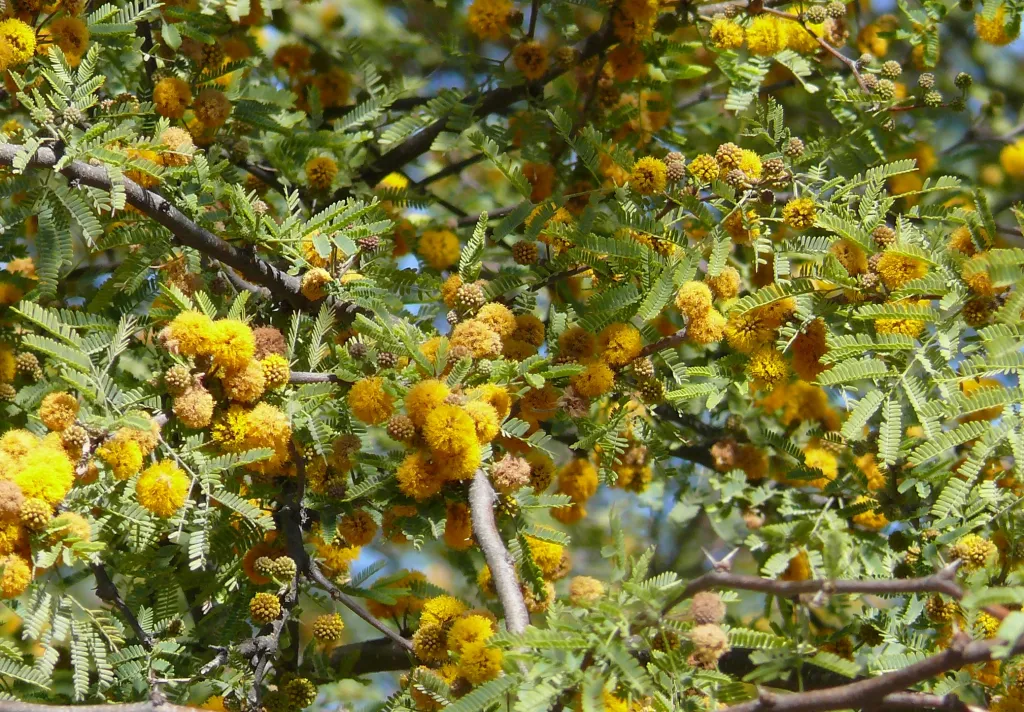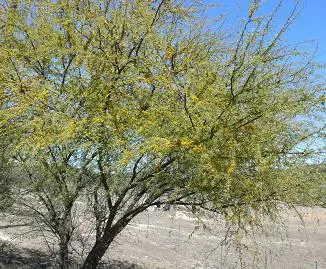Author: Bill Ward
Texas has a large number of Acacia, as many as 17 or 18 species and varieties, according to which taxonomist is making the list. Some members of that genus are excellent small trees and shrubs for landscaping in this area. As our water supply in the Hill Country continues to diminish, we ought to think more about acacias as yard plants.
Acacias are some of the most drought-tolerant bushes and trees one can grow. Once established, they need no water except what Mother Nature provides. Even during this historically severe drought, the acacias seem to be surviving just fine. Several species of Acacia fit the bill as an Operation NICE! (Natives Instead of the Common Exotics!) Plant of the Month. They look good in the yard but require little or no water, fertilizer, and other care.

The acacia probably best known to Central and South Texans is huisache (Acacia farnesiana or A. smallii), also known as sweet acacia. This spiny acacia has feathery doubly compound leaves with 10-18 pairs of tiny secondary leaflets. Usually it gets no more than about 15-20 feet high in this area. During early spring, the branches are densely packed with half-inch spheres of bright-golden-yellow blossoms.
Some of the prettiest early-spring sights in northeastern Mexico are broad valleys covered in huisache trees. On February mornings, the whole landscape glows golden yellow as far as the eye can see.
Reportedly, “huisache” comes from an Aztec word, huitz-axin. “Huitz” means it, he, or she comes, and “axin” is a yellow oily substance derived from a bug and used to stain skin and other things yellow. Perhaps, then, huitz-axin refers to this acacia becoming yellow in the spring. That’s merely a guess.
Huisache may not always be available in nurseries, because some people consider it a trash tree. In South Texas it rapidly infests disturbed land and is consider a nuisance by many ranchers. However, on the eastern Edwards Plateau it seems much less likely to spread out of control. We’ve had two small huisache trees in our yard for years. They grow slowly and have not multiplied.
Our most common local acacia is Roemer’s acacia (A. roemeriana), sometimes called catclaw. This multi-branched shrub or small tree has doubly compound leaves with 4-8 pairs of leaflets. In late spring it puts on round, fluffy clusters of white flowers. The curved catclaw-like thorns will get your attention if you brush against this shrub.

Another species of catclaw acacia (A. greggii var. greggii and var. wrightii) grows in the South Texas brush country, Trans-Pecos, and part of northwest Texas. This acacia can grow to 25 or 30 feet high. It has twice-compound leaves 1-2 inches long. Leaflets number 2-6 pairs. Instead of the bloom head being spherical as in Roemer’s acacia, flowers are cylindrical spikes of many tiny white flowers. This is the most-cold-hardy acacia native to Texas and probably can be used effectively in landscapes in northern Texas (Sally Wasowski, “Native Texas Plants, Landscaping Region by Region”).
Another acacia shrub that does well in our yard is guajillo (A. berlandieri), native to South Texas and the southern edge of the Edwards Plateau. This acacia has airy compound leaves with 5-9 pairs of primary leaflets and 30-50 pairs of secondary leaflets. In South Texas it produces white ball-shaped flower heads from November to March. In our yard it blooms in the spring, and its white flowers are a nice complement to the bright-yellow rounded bloom heads of a nearby goldenball leadtree.
There also exists a Texas acacia which can be used as a groundcover. Fern acacia (A. angustissima) is a low-growing shrub with delicate, fern-like foliage. Its leaflets close together at night and when touched. Unlike most other acacias, fern acacia is thornless. White round flowers appear from time to time during the summer and fall. It is hardy in full sun or partial shade, and it never needs watering. Fern acacia fits into the unkempt wildscape of our backyard, but it spreads by rhizomes and might be too unruly for many gardens.
